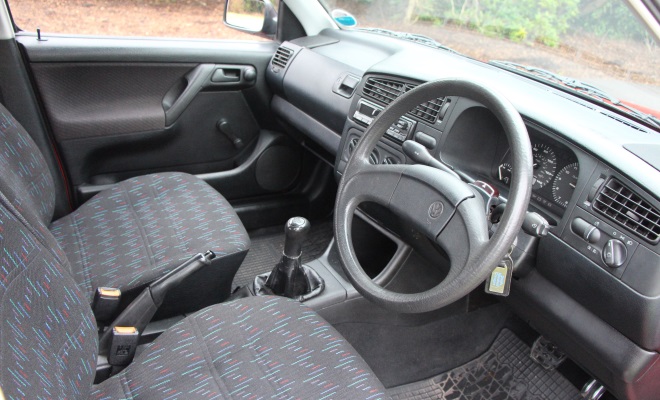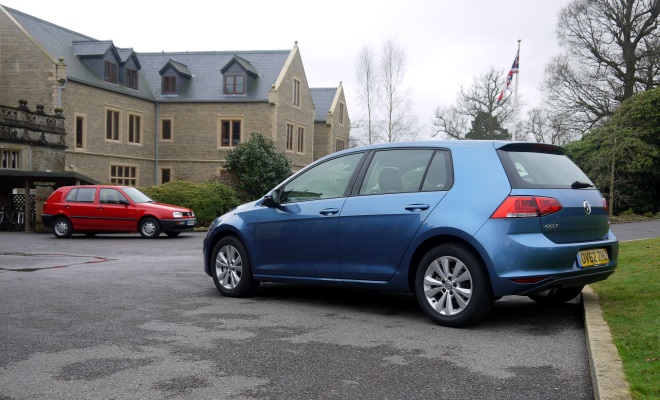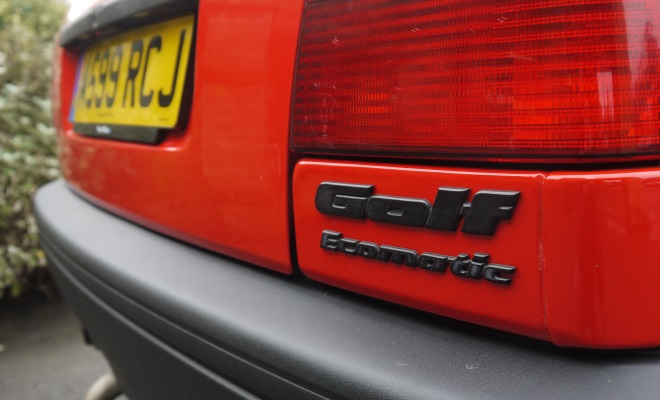
This feels weird, to say the least. I’ve driven quite a wide variety of automatic and manual cars over the past few years, but this is a first for me. I’m driving a 1994 Volkswagen Golf Ecomatic that features manual gears paired with an automated clutch. To swap cogs I simply lift off the throttle, slide the lever through an ordinary H-gate, and press on again.
Aside from my left foot’s tendency to think the brake is a clutch, it all comes together marvellously. I can’t think why more cars don’t work this way. For one thing, you can’t stall. The clutch simply waits for enough revs to build before bothering to release, as if I might be driving a giant four-wheeled moped.

The unusual choice of an automated clutch was a necessity for this particular car, because it was built to fully exploit the potential of engine stop-start technology. An engine that shuts down at rest is now quite commonplace among new cars, but this old Volkswagen system is a much more ambitious effort than today’s timid breed. It doesn’t simply shut down when you sit at traffic lights, it cuts out when you’re on the move as well.
Which sounds alarming but isn’t. The trick is to have the engine start promptly when you need it, and to shut down only at times when you don’t. And to ensure you never lurch to an inglorious halt, the clutch simply opens itself wide before the engine switches off. As a result, the Golf can glide effortlessly and silently along at high speed, coasting in a way that my driving instructor taught me never to do under any circumstances.
Obviously the above is a somewhat over-simplified description of the technicalities, given that it is quite handy to enjoy features like power steering and assisted brakes when hurtling along at speed, engine running or not. Fortunately, plenty of Germanic brainpower has overseen the fitting of various electric motors and vacuum pumps to ensure essential systems carry on working, with or without the engine.

The engine bay is also home to two separate 12-volt batteries: a truck battery that looks fit to crank the Bismarck, plus a small motorcycle item to stop the lights flickering while the bruiser boots up the engine. The main battery is comically big to make sure the starter motor never goes all slurred and sleepy when you’d quite like the engine to wake up right now, please, because you’re about to merge between barrelling juggernauts on the M1.
The engine itself is a venerable non-turbo 1.9-litre diesel, chosen because of its extreme reliability in the business of warm restarts. One can only wonder what this system might have been like if developed by Lucas and fitted to a contemporary Austin Maestro.

I’m driving this piece of green motoring history courtesy of its maker, Volkswagen. The company now fits stop-start as standard to its new seventh-generation Golf hatchback, and is keen to highlight its pedigree in this area. So it simply went out and bought an old Ecomatic, gave it a full service and a deep clean, and began lending it out for test drives.
To be honest the clean might have been deeper – the ghosts of cigarettes and old socks still linger – but everything important seems to work as the odometer homes in on 70,000 miles. The driving experience takes a little getting used to. I oscillated between thinking there must be a clutch and entirely forgetting to change gear for the first 15 minutes, but eventually the mind accepts the need to shift the stick without moving the left foot.
There’s no tacho among the major instruments, just a speedo and a giant ugly timepiece, but there is an orange warning lamp suggesting when I might want to change up. There’s no downshift light, though, with that decision left as an exercise for the driver.

There’s never any mistaking whether the engine is running or not. This is an early 90s diesel after all, offering the full spectrum of rattles, booms, shakes and judders. A distinct wobble runs through the whole car when the engine dies, while a quick crank and throaty cough is heard as it starts again. There’s also a button on the wiper stalk that turns off the stop-start function, but I’m managing perfectly well without it.
Despite a relatively paltry peak of just 64bhp when new, the old engine still has some grunt to offer, and the Ecomatic feels neither slow nor asthmatic. And surprisingly, that’s not because the old Golf bodyshell is flimsy and light – it actually weighs roughly the same as today’s car, which has been on a 100kg diet after the heavyweight Mk VI.
Jumping from a brand new Golf 7 into a 1994 heirloom is breathtaking, and not just because of the smell. The strides made by the automotive industry in the past two decades are truly huge, and are much more apparent inside than out. Refinement in the old car is most noticeable by its utter absence, and it’s hard to believe this Golf ever provided a benchmark for interior quality. Today, the grade of plastic used on the dashboard seems better suited to a kitty-litter tray, the windows wind up with a big and flimsy handle, and the shrivelled black mushrooms that sprout from each door are there to give the vaguest of hints to the mirrors about which way they might want to point.

By comparison, today’s Golf feels like an airline upgrade from mid-row Economy to a private jet.
Probably because it is now such a curio, the Golf Ecomatic produces nothing but broad grins as I drive. It’s all the more remarkable to consider that the Ecomatic was not VW’s first foray into production stop-start technology. I believe the first such car to go on sale was the Polo Formel E, a whole decade earlier, in 1984.
Fewer than a hundred Golf Ecomatics found UK homes and no doubt the car’s list price was a problem even if the unfamiliar technology was not. Starting at £11,495, the Ecomatic demanded a 15% premium over the base model 1.9 diesel. Today, only a handful of Ecomatics can still be found gliding along British roads.

But even today, the lofty ambition behind this old Golf is worth pausing to consider, particularly in the light of the results. According to VW, compared to a standard equivalent car, the Ecomatic system cut carbon monoxide output by 36%, hydrocarbon and NOx pollution by a quarter, particulate emissions by 11%, and CO2 output by 22%.
Today’s stop-start systems cut CO2 emissions by around 5% or so, and I can’t help wondering if this old Golf might teach today’s breed a few tricks. Currently, only hybrids dare to switch off their engine while out on the highway. Perhaps more modern cars might benefit from the Ecomatic’s brave capability to simply shut down and coast.
History today: driving the 1994 Golf Ecomatic
15 January 2013
Read more about: fuel economy history test drives Volkswagen



